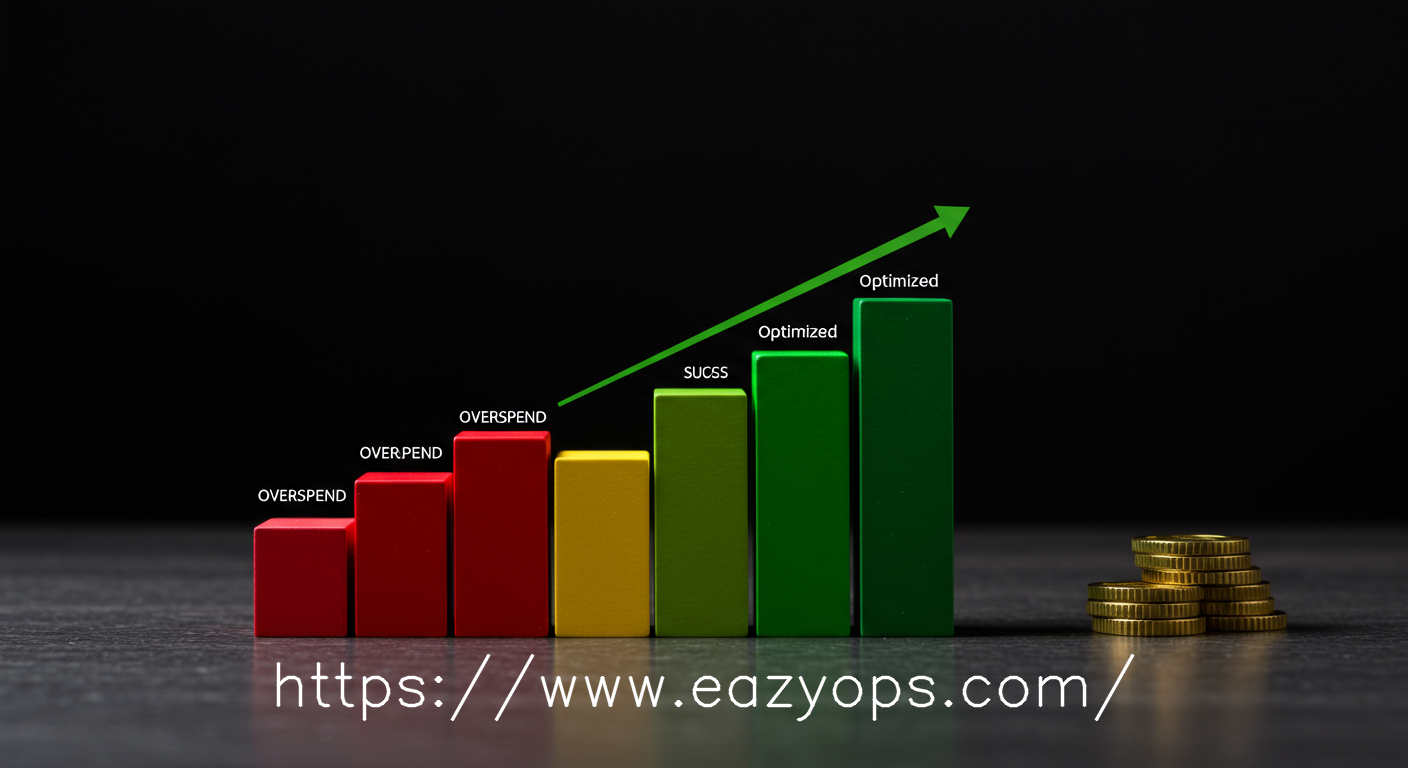Azure Cosmos DB Provisioning Overkill: Our $5,400 Monthly Mistake
"Developers provisioned 100,000 RU/s while actual workload used <10,000 RU/s. EazyOps flagged misalignment and switched workloads to autoscale—cutting $5,400 monthly."
The email hit my inbox like a lead balloon: "Azure bill spike - Cosmos DB." As a lead platform engineer, that phrase usually meant late nights and frustrated developers. Our monthly cloud bill had jumped by an unexpected $5,400, and the culprit was clearly identified: Azure Cosmos DB.
Upon closer inspection, the numbers were baffling. A critical application's Cosmos DB instance was provisioned with a staggering 100,000 Request Units per second (RU/s). Yet, our telemetry data showed that during peak usage, the actual consumption rarely exceeded 10,000 RU/s. For most of the day, it hovered between 2,000 and 5,000 RU/s.
This wasn't just a small miscalculation; it was a 10x over-provisioning. Imagine buying a super-highway with 100 lanes, only for 10 cars to drive on it at any given time. We were paying a premium for capacity that simply wasn't being used, all in the name of perceived safety.
The team that owned the application was under immense pressure to deliver new features. When asked about the high RU/s, their response was classic: "We can't risk performance issues. Better safe than sorry." This mindset, while understandable, was silently bleeding our budget dry, month after month.
The Endless Manual Treadmill
Our initial attempts to tackle this problem followed the well-worn path of manual FinOps. I pulled up Azure Cost Management reports, exported CSVs, and spent hours in spreadsheets trying to correlate Cosmos DB charges with actual usage metrics from Azure Monitor. It was like piecing together a puzzle with half the pieces missing.
We tried to enforce a policy: "Review your Cosmos DB RUs monthly!" This was met with polite nods but little action. Developers were drowning in their sprint backlogs; adding manual cost optimization to their plate felt like an extra chore, not a priority. For them, ensuring application responsiveness was paramount, and manually tweaking RU/s based on fluctuating traffic patterns was a terrifying prospect that could lead to throttling errors and frustrated users.
- The Fear Factor: Under-provisioning RUs leads to throttling, which can crash an application or degrade user experience. The perceived risk of being throttled far outweighed the abstract concept of "cost savings."
- Complexity of Estimation: Accurately estimating RU/s needed for complex queries, document sizes, and indexing strategies is an art, not a science, for many developers. It's often easier to just pick a high number.
- Bursty Workloads: Our applications often had unpredictable spikes. Manually scaling RUs up and down for these bursts was impractical and often resulted in us keeping the highest provisioned RUs active just in case.
We even set up alerts for high provisioned-to-consumed RU ratios, but these were either too noisy (triggering for temporary dips in traffic) or too late (by the time we reacted, weeks of overspending had already occurred). We were stuck in a reactive cycle, constantly playing catch-up, and the $5,400 monthly waste continued.


EazyOps and the Revelation of Autoscale
The turning point came when we started evaluating EazyOps. We needed a tool that could go beyond raw billing data and provide actionable insights, specifically for highly dynamic services like Cosmos DB.
EazyOps' initial scan of our Azure environment immediately flagged the over-provisioned Cosmos DB instance. It didn't just tell us we were spending too much; it presented a clear, data-backed analysis:
- Deep Usage Analytics: EazyOps integrated directly with Azure Monitor metrics, providing a historical view of actual RU consumption, not just what was provisioned.
- Intelligent Anomaly Detection: It quickly identified the 100,000 RU/s setting as an extreme outlier compared to actual utilization patterns, highlighting the 10x over-provisioning.
- Autoscale Recommendation: Crucially, it didn't just point out the problem. EazyOps suggested a concrete solution: migrate the container to Cosmos DB's autoscale provisioned throughput mode. It even projected the exact monthly savings, which validated our $5,400 figure.
This was our "Aha!" moment. We realized that manual oversight was a losing battle. What we needed was an intelligent, automated system that understood cloud services at a deeper level than we ever could with spreadsheets and dashboards.
Empowering with Smart Automation
With EazyOps, the solution wasn't just a recommendation; it was an actionable pathway. We were able to leverage EazyOps' insights to directly address the Cosmos DB over-provisioning.
The process was surprisingly straightforward. EazyOps provided us with a clear, step-by-step guide to switch the identified Cosmos DB container to autoscale mode. It also offered the option to monitor the change and revert if necessary, providing a safety net that eased any lingering developer anxieties.
How EazyOps Facilitated the Fix:
- Data-Driven Confidence: EazyOps' detailed usage graphs and projected savings gave us the confidence to make the change, reassuring the development team that performance wouldn't be compromised.
- Simplified Transition: While the actual switch to autoscale was an Azure operation, EazyOps provided the critical intelligence (when to switch, what target RUs to aim for, what the impact would be) that made the decision-making process seamless.
- Continuous Validation: Post-switch, EazyOps continued to monitor the autoscale configuration, ensuring it was dynamically adjusting to workload changes and maintaining optimal cost-efficiency without manual intervention.
- Developer Buy-in: By presenting clear data and demonstrating the ease and safety of the transition, EazyOps helped us get immediate buy-in from the development team. They saw it as an enhancement that removed a management burden, not a restriction.
This shift wasn't just about changing a setting; it was about changing our approach to cloud resource management. We moved from fearful over-provisioning to intelligent, dynamic scaling, all driven by EazyOps' ability to understand our actual needs.

Immediate Impact: Savings and Sanity
The results were not just encouraging; they were transformative. Within the first month of switching that single Cosmos DB instance to autoscale, we saw:
Financial Savings:
- $5,400 monthly savings: This single change instantly cut our Cosmos DB related overspend.
- ~65% reduction in RU costs: The application went from being a major cost center to an efficiently run service.
- Immediate ROI on EazyOps: The savings from this one instance alone covered a significant portion of our investment in EazyOps.
Operational Efficiency:
- Zero performance degradation: The application maintained its responsiveness, even during peak loads, proving autoscale was just as reliable as manual over-provisioning.
- Reduced operational burden: Developers no longer had to worry about manually adjusting RUs or fearing throttling.
- Improved FinOps posture: We shifted from a reactive firefighting mode to a proactive optimization strategy for Cosmos DB.
This success story wasn't just about money saved; it was about building trust. It showed our development teams that cost optimization could go hand-in-hand with performance and reliability, without adding to their workload. It also showcased the power of intelligent automation to solve complex cloud challenges.

Key Takeaways from Our Cosmos DB Journey
Our experience with the Azure Cosmos DB provisioning overkill taught us several invaluable lessons about managing cloud costs in a dynamic environment:
- Manual Provisioning is a Trap for Bursty Workloads: For services with variable traffic, static provisioning almost always leads to either overspending (for safety) or performance issues (from under-provisioning). Autoscale is designed for this unpredictability.
- Fear of Under-Provisioning is a Major Cost Driver: Developers, rightly focused on application stability, will often choose the highest safe tier. Without clear, automated data and easy solutions, this behavior is rational but expensive.
- Intelligent Monitoring is Non-Negotiable: Raw billing data isn't enough. You need tools that can correlate consumption with provisioning, understand service-specific metrics (like RUs), and recommend actionable changes.
- Autoscaling isn't Just for Performance: While often lauded for its ability to handle traffic spikes, autoscaling is an equally powerful cost optimization tool, ensuring you only pay for what you actually use.
- Bridging the FinOps-DevOps Gap: Solutions that seamlessly integrate into existing workflows and provide data-driven recommendations that developers can trust are key to fostering a culture of cost-awareness without hindering velocity.
This wasn't just about saving money; it was about optimizing our cloud footprint, empowering our teams, and making smarter decisions about our infrastructure.
The Future of Intelligent Cloud Cost Management
Our success with Cosmos DB autoscale is just one example of the broader trend in cloud FinOps. As cloud environments grow in complexity, the need for intelligent, automated cost management becomes paramount. Manual reviews simply cannot keep up.
At EazyOps, we're continuously evolving to tackle these challenges. The future isn't just about finding waste; it's about predicting it, preventing it, and making optimization an integral, invisible part of the development lifecycle.
- Proactive Waste Prevention: Moving beyond reactive alerts to systems that can identify potential over-provisioning at the design or deployment stage.
- Cross-Service Optimization: Applying similar intelligent analysis to other notoriously complex cloud services like Azure Functions, Data Factory, or SQL Database.
- Contextual Cost-to-Value: Integrating cost data with business metrics to understand the true ROI of every cloud dollar spent, not just the raw expenditure.
The companies that embrace intelligent automation for their FinOps will not only save significant capital but will also gain a competitive edge through more efficient resource utilization, faster innovation, and a more sustainable cloud footprint.
Don't let your valuable resources get lost in a provisioning overkill. Embrace smart solutions, and let your engineers focus on what they do best: building amazing applications.
About Shujat
Shujat is a Senior Backend Engineer at EazyOps, working at the intersection of performance engineering, cloud cost optimization, and AI infrastructure. He writes to share practical strategies for building efficient, intelligent systems.